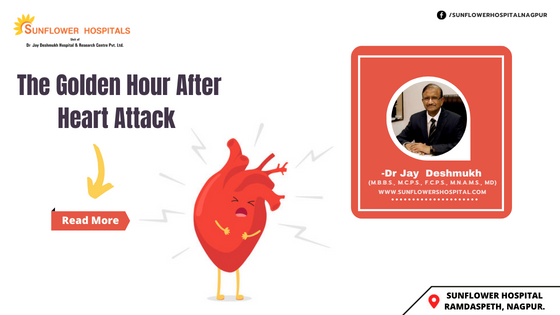Why is the first hour after a heart attack a window of opportunity?
The first hour after a heart attack is the most important hour after a heart attack. Time is muscle. Hence earlier the person gets treated less would be damage to his heart muscle. This is because the heart muscle starts dying within 80 to 90 minutes after a heart attack. Heart attack results due to complete occlusion of the coronary artery. Opening this artery within the first hour prevents permanent damage to the heart muscle. If the blood supply is not restored in 6 hours, it leads to permanent damage to the heart muscle.
What are the consequences of reaching late to the hospital?
The common killer during the first hour is abnormal ventricular beats. These are known as ventricular tachycardia or fibrillation. No effective pumping takes place during this period. Once the person reaches the hospital, he is immediately put on a cardiac monitor to assess his heart rhythm. Some require intravenous medications to reverse the abnormal rhythm, or some require a shock to the chest by a defibrillator to convert it into a normal rhythm. Some may even require a temporary pacemaker.
What are the steps taken to reach the hospital during the golden hour?
Clinical assessment of the patient is necessary to recognize symptoms. Please call for help immediately. Reach the hospital Mimediately to confirm diagnosis and start appropriate treatment. Time is muscle. Lesser the time taken to reach the hospital, the more would be the survival rate and less irreversible damage would occur to the heart muscle.
What steps are taken on admission to the hospital?
Serial ECGs are taken social in taking an appropriate decision.
What are the common signs of a heart attack?
Severe pain in the center of the chest, pain on the left side of the chest, sweating, a sense of suffocating or breathlessness, and extreme restlessness are the key symptoms. Diabetics may not have chest pain. Sometimes vomiting, pain in the pit of the stomach or backache, or pain in the shoulders may indicate a heart attack. Gastric symptoms may mimic heart attacks. Some may have only restless-ness, sweating, or mild breathing difficulty.
What is the preparation at home even before a heart attack?
Please make sure that you The first hour after the onset of a heart attack is called the golden hour. Appropriate action taken during this period can reverse the damage due by a heart attack. Most of the deaths and cardiac arrests occur during this period. If the patient gets appropriate therapy during this period, he can expect complete recovery with no permanent damage to his heart. confirm the diagnosis. Blood is withdrawn for certain tests. These may include blood glucose, kidney function tests including Sodium and Potassium, and cholesterol profile. If there is a doubt of diagnosis, then iftny chest and echocardiogram are necessary. The patient can either undergo a primary angioplasty or he is given intravenous drugs to dissolve the clots in the coronary artery. Depending upon the facilities available, the affordability and the expertise and the availability of experts particularly on weekends have telephone numbers of ambulances or hospitals at hand and well stored. Try to reach the nearest hospital where facilities for thrombolytic therapy and angioplasty are available. Try to go by a cardiac ambulance. Do not try to drive yourself as it may harm others and yourself too. If possible carry your medical documents with you.
What is the door to balloon concept?
This is a time measurement in emergency cardiac care specifically in the treatment of ST-segment elevation myocardial infarction. STEW. The interval starts with the patient’s arrival in the emergency department and ends with the catheter guide wire crossing the culprit lesion in the cardiac catheter laboratory. American Heart Association guidelines rec. commend a door-to-balloon interval of no more than 90 minutes. It is a core quality measure. Unfortunately in India, less than 20% of people receive this primary care, though the acceptance is improving.
What are the strategies to be in place to reduce the door to balloon time?
The emergency department activates the catheter laboratory. The single-call activation system activated the catheter lab. The Cath lab team is available in 20:30 minutes. There is prompt data feedback. Senior management commitment and a team-based approach are necessary. How to prevent the need for treatment in the golden hour? This means to prevent heart attack. Try to avoid smoking and tobacco products. Lead an active healthy life. Keep your cholesterol, diabetes, and blood pressure under tight control. Reduce weight and walk at least 30 minutes daily. Be happy, relaxed, and contented. The first hour after a heart attack is the most important phase in the management of heart attack. Prompt treatment in terms of primary angioplasty or if facilities are not available or there is a constraint of expertise, drugs to dissolve the clot is necessary. Time is muscle. The first hour of treatment decides the long-term survival of the patient.


